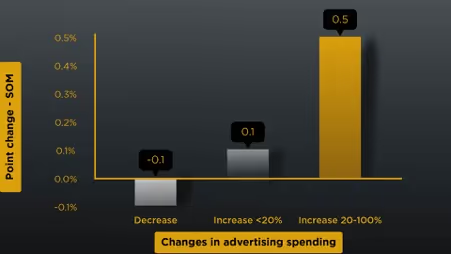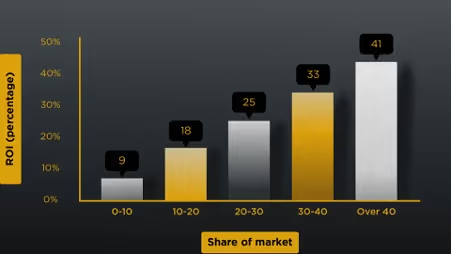
How to manage your marketing mix when budgets are under pressure
In today’s climate, businesses of all sizes are feeling the squeeze. While we’re not in a formal recession (at least, not at the time of writing), we are facing rising costs, cautious consumer spending, and mounting internal pressure to justify every penny.
Understandably, marketing budgets are under scrutiny – and for many, the instinct is to cut spend, pause campaigns, and wait it out. But the evidence tells a different story. Now, more than ever, marketing teams need to be proactive, not reactive.
Beyond recession-proofing – this is about future-proofing
Even outside of a recession, the lessons of past downturns still hold weight. A Harvard Business School study of 4,700 businesses during past recessions found that those who reduced costs selectively were 37% more likely to come out of the period in a stronger position than their competitors.
By focusing more on operational efficiency, while investing in marketing, R&D, and new assets, these businesses could stay ahead of the competition and hit the ground running when the economy bounced back.
“…those who reduced costs selectively were 37% more likely to come out of the period in a stronger position than their competitors…”
To many, this may feel counter-intuitive. But brand growth is driven by an investment in long-lasting commercial impact. And, as any professional investor will tell you, success lies in buying low and selling high. In times of recession, media is cheaper, and the landscape is quieter as your competitors begin to retreat. So, the longer-term impact – as we come out of recession – should be greater.
That’s the theory anyway.
Luckily, there’s robust data to support this theory.The WPP Centre for Research and Development provides us with important insights from the past into the performance of brands through a downturn. It bases its analysis on data from the Profit Impact of Market Strategy (PIMS) database.
The PIMS database is the only source from the past that contains both marketing data and financial information for the same brands throughout the period of the study.
Cutting advertising doesn’t increase short-term profits
It’s tempting for businesses to show bottom-line results by cutting advertising spend in a downturn, especially when under pressure to report short-term quarterly results to investors.
However, the PIMS data shows that cutting advertising spend in a downturn doesn’t increase your short-term profits.
The WPP paper concludes: “Those that cut their advertising expenditure in a recession lose no less in terms of profitability than those who actually increase spending by an average of 10%. In other words, cutting advertising spend to increase short-term profits doesn’t seem to work.”
Increasing spend in tough economic periods grows market share
Whilst it might seem risky to increase spend in a challenging economy, the data from the PIMS database shows that it’s easier to gain market share in a downturn than it is in better market conditions.
“Businesses in the PIMS database enjoy a higher rate of share growth during downturns, and a lower rate of share increase during stable periods and periods of growth.” (Source: Options and Opportunities for Consumer Businesses: Advertising During a Recession, Alexander L. Biel and Stephen King.)


Increasing market share increases marketing ROI in the long run.
Increasing marketing spend in a downturn will naturally show a short-term fall in ROI for most businesses, depending on their sector. Figure 3 shows, on average a reduction of 1.9%.
However, there’s only a 0.1% difference between those cutting their spend by an average of 11%, and those increasing spend by an average of 10%. (Source: Options and Opportunities for Consumer Businesses: Advertising During a Recession, Alexander L. Biel and Stephen King.)

As we’ve seen from the data in Figure 1, even a moderate increase in spend resulted, on average, in an increased market share during a downturn.
For larger increases in investment, the WPP paper comments: “Brands increasing their spending by an average of 48% during a recession win virtually double the share gains of those who increase their expenditures more modestly. While this aggressive increase in advertising is associated with a drop in return on investment of 2.7% in the short term, it may nevertheless be acceptable to the marketer looking ahead to post-recession growth.”
Further, as demonstrated in figure 4, there’s a substantial body of evidence to show that a larger share of the market generally leads to a higher return on marketing investment in the longer term. (Source: Options and Opportunities for Consumer Businesses: Advertising During a Recession, Alexander L. Biel and Stephen King.)

So, we know there’s a case for being especially intentional about marketing during a downturn. But what should that look like?
A proactive approach to marketing during a recession should focus on maintaining a consistent and confident presence. This means keeping up with brand awareness campaigns and ensuring your identity, messaging and value proposition stay true, relevant and strong. It’s the wrong time to shy away from stand-out, brand-led marketing.
As The Drum puts it: “All these brand DNA pieces need to be considered and are valuable in building strong, long-lasting relationships with customers – especially during tough economic times where they are more cautious with where and how they are spending their money.”
So even scaling back on advertising could be a mistake if you want to gain market share and a competitive advantage. And while investing in SEO, PPC and lead generation might seem more pressing than brand and awareness, a strong, visible presence might just be the key to long-term success.
Case study – Proctor & Gamble
Don’t dismiss this case study because P&G is a large consumer brand. Studies by Binet & Field show that the principles of B2C brand building apply equally to B2B brands.
Without a doubt, the decisions we make today will affect the health of our businesses substantially for the longer term. So now, more than ever, we should ground our strategies in empirical data to avoid strategies based on fear and emotion.
So, while we’re all under considerable pressure to revisit our marketing strategies, remember the evidence from the past:
- Businesses that continue investing in marketing through a downturn, funded by operational efficiencies, are 37% more likely to come out of the recession stronger than their competitors.
- Those cutting advertising see no less profits than those who increase spend by 10%.
- Modest increases in spend during a downturn result in increased market share.
- Increased market share generally leads to increased ROI in the mid to long term.
- Those increasing spend aggressively by an average of 48% double the increase in market share over those investing more modestly. (Although their ROI is reduced more substantially in the short term).
Need help building or refocusing your brand?
Whether you’re reviewing your strategy, refreshing your identity, or aligning your digital presence to meet today’s pressures, we’re here to help.
Ready to make your brand work harder?
If you’re ready to get a second opinion on your brand’s effectiveness, we’re here to help.
Book a free 30-minute brand consultation with one of our experts.








